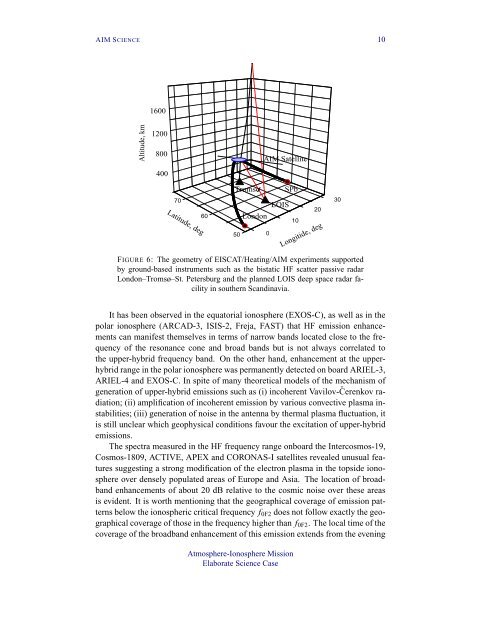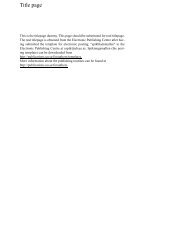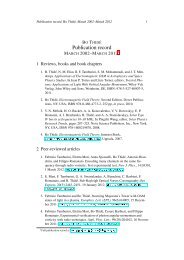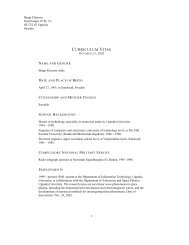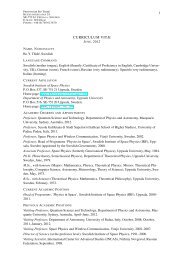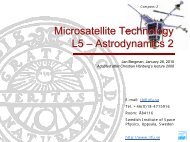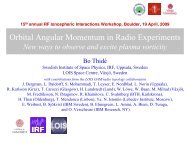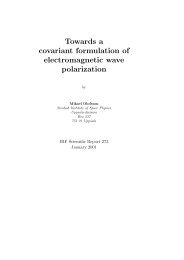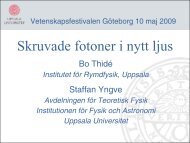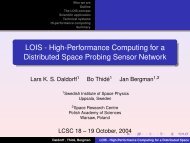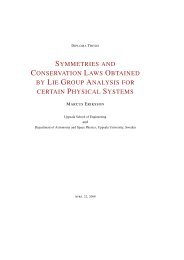Atmosphere-Ionosphere Mission - Swedish Institute of Space ...
Atmosphere-Ionosphere Mission - Swedish Institute of Space ...
Atmosphere-Ionosphere Mission - Swedish Institute of Space ...
Create successful ePaper yourself
Turn your PDF publications into a flip-book with our unique Google optimized e-Paper software.
AIM SCIENCE 10<br />
FIGURE 6: The geometry <strong>of</strong> EISCAT/Heating/AIM experiments supported<br />
by ground-based instruments such as the bistatic HF scatter passive radar<br />
London–Tromsø–St. Petersburg and the planned LOIS deep space radar facility<br />
in southern Scandinavia.<br />
It has been observed in the equatorial ionosphere (EXOS-C), as well as in the<br />
polar ionosphere (ARCAD-3, ISIS-2, Freja, FAST) that HF emission enhancements<br />
can manifest themselves in terms <strong>of</strong> narrow bands located close to the frequency<br />
<strong>of</strong> the resonance cone and broad bands but is not always correlated to<br />
the upper-hybrid frequency band. On the other hand, enhancement at the upperhybrid<br />
range in the polar ionosphere was permanently detected on board ARIEL-3,<br />
ARIEL-4 and EXOS-C. In spite <strong>of</strong> many theoretical models <strong>of</strong> the mechanism <strong>of</strong><br />
generation <strong>of</strong> upper-hybrid emissions such as (i) incoherent Vavilov-Čerenkov radiation;<br />
(ii) amplification <strong>of</strong> incoherent emission by various convective plasma instabilities;<br />
(iii) generation <strong>of</strong> noise in the antenna by thermal plasma fluctuation, it<br />
is still unclear which geophysical conditions favour the excitation <strong>of</strong> upper-hybrid<br />
emissions.<br />
The spectra measured in the HF frequency range onboard the Intercosmos-19,<br />
Cosmos-1809, ACTIVE, APEX and CORONAS-I satellites revealed unusual features<br />
suggesting a strong modification <strong>of</strong> the electron plasma in the topside ionosphere<br />
over densely populated areas <strong>of</strong> Europe and Asia. The location <strong>of</strong> broadband<br />
enhancements <strong>of</strong> about 20 dB relative to the cosmic noise over these areas<br />
is evident. It is worth mentioning that the geographical coverage <strong>of</strong> emission patterns<br />
below the ionospheric critical frequency f 0F2 does not follow exactly the geographical<br />
coverage <strong>of</strong> those in the frequency higher than f 0F2 . The local time <strong>of</strong> the<br />
coverage <strong>of</strong> the broadband enhancement <strong>of</strong> this emission extends from the evening<br />
<strong>Atmosphere</strong>-<strong>Ionosphere</strong> <strong>Mission</strong><br />
Elaborate Science Case


